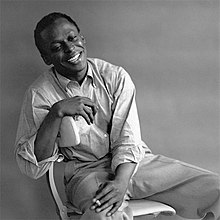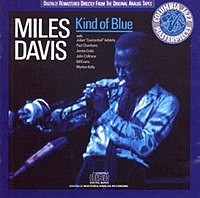
Miles Dewey Davis III was an American jazz trumpeter, bandleader, and composer. He is among the most influential and acclaimed figures in the history of jazz and 20th-century music. Davis adopted a variety of musical directions in a roughly five-decade career that kept him at the forefront of many major stylistic developments in jazz.
Modal jazz is jazz that makes use of musical modes, often modulating among them to accompany the chords instead of relying on one tonal center used across the piece.

Hard bop is a subgenre of jazz that is an extension of bebop music. Journalists and record companies began using the term in the mid-1950s to describe a new current within jazz that incorporated influences from rhythm and blues, gospel music, and blues, especially in saxophone and piano playing.

George Allen Russell was an American jazz pianist, composer, arranger and theorist. He is considered one of the first jazz musicians to contribute to general music theory with a theory of harmony based on jazz rather than European music, in his book Lydian Chromatic Concept of Tonal Organization (1953).
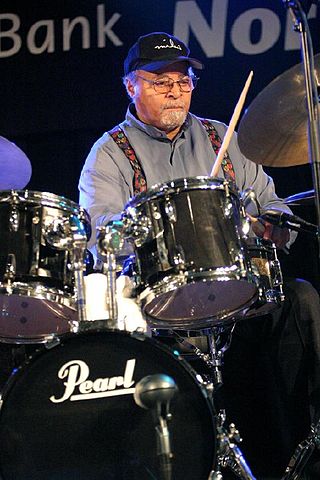
Wilbur James "Jimmy" Cobb was an American jazz drummer. He was part of Miles Davis's First Great Sextet. At the time of his death, he had been the Sextet's last surviving member for nearly thirty years. He was awarded an NEA Jazz Masters Fellowship in 2009.
Ashley Kahn is an American music historian, journalist, and producer. He was born in the Bronx, New York, and was raised in Cincinnati. Kahn graduated from Columbia University in 1983. While attending Columbia, he hosted a jazz and blues radio show on WKCR, and was known on the air as "The Cincinnati Kid."
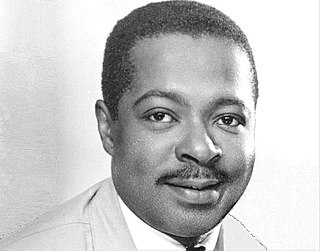
Wynton Charles Kelly was an American jazz pianist and composer. He is known for his lively, blues-based playing and as one of the finest accompanists in jazz. He began playing professionally at the age of 12 and was pianist on a No. 1 R&B hit at the age of 16. His recording debut as a leader occurred three years later, around the time he started to become better known as an accompanist to singer Dinah Washington, and as a member of trumpeter Dizzy Gillespie's band. This progress was interrupted by two years in the United States Army, after which Kelly worked again with Washington and Gillespie, and played with other leaders. Over the next few years, these included instrumentalists Cannonball Adderley, John Coltrane, Hank Mobley, Wes Montgomery, and Sonny Rollins, and vocalists Betty Carter, Billie Holiday, and Abbey Lincoln.

Milestones is a studio album by Miles Davis. It was recorded with his "first great quintet" augmented as a sextet and released in 1958 by Columbia Records.

Someday My Prince Will Come is the seventh studio album by Miles Davis for Columbia Records, catalogue CL 1656 and CS 8456 in stereo, released in 1961. Recorded at Columbia's 30th Street Studio in Manhattan, New York City, it marked the only Miles Davis Quintet studio recording session to feature saxophonist Hank Mobley.

Porgy and Bess is a studio album by jazz musician Miles Davis, released in March 1959 on Columbia Records. The album features arrangements by Davis and collaborator Gil Evans from George Gershwin's 1935 opera of the same name. The album was recorded in four sessions on July 22, July 29, August 4, and August 18, 1958, at Columbia's 30th Street Studio in New York City. It is the second collaboration between Davis and Evans and has garnered much critical acclaim since its release, being acknowledged by some music critics as the best of their collaborations. Jazz critics have regarded the album as historically important.
"So What" is the first track on the 1959 album Kind of Blue by American trumpeter Miles Davis.
"Freddie Freeloader" is a composition by Miles Davis and is the second track on his 1959 album Kind of Blue. The piece takes the form of a twelve-bar blues in B♭, but the chord over the final two bars of each chorus is an A♭7, not the traditional B♭7 followed by either F7 for a turnaround or some variation of B♭7 for an ending.
"Blue in Green" is the third tune on Miles Davis' 1959 album, Kind of Blue. One of two ballads on the LP, the melody of "Blue in Green" is very modal, incorporating the presence of the Dorian, Mixolydian, and Lydian modes. This is the only tune on which Cannonball Adderley sits out.

The Complete Columbia Recordings of Miles Davis with John Coltrane is a box set featuring jazz musicians Miles Davis and John Coltrane. It is the first box set in a series of eight from Columbia/Legacy compiling Davis's work for Columbia Records, and includes never-before-released alternate takes, omissions of other musicians, musician comments, false starts and a first version of compositions, some of which have made it to the 50th Anniversary 2-disc CD version of Kind of Blue. Originally issued on April 11, 2000, in a limited-edition metal slipcase, it was reissued in 2004 in an oversized book format. In conjunction with Sony, Mosaic Records released the 9-LP set.

1958 Miles is a compilation album by American jazz musician Miles Davis, released in 1974 on CBS/Sony. Recording sessions for tracks that appear on the album took place on May 26, 1958, at Columbia's 30th Street Studio and September 9, 1958, at the Plaza Hotel in New York City. 1958 Miles consists of three songs featured on side two of the LP album Jazz Track, which was released in November 1959, one song from the same session not appearing in the album, and three recordings from Davis' live performance at the Plaza Hotel with his ensemble sextet. The recording date at 30th Street Studio served as the first documented session to feature pianist Bill Evans performing in Davis' group.

Jazz at the Plaza Vol. I is a live album by The Miles Davis Sextet. It was recorded in 1958 and released in 1973 by Columbia Records. Duke Ellington was recorded at the same event and released as the second volume (Jazz at the Plaza Vol. II).

By the end of the 1940s, the nervous energy and tension of bebop was replaced with a tendency towards calm and smoothness, with the sounds of cool jazz, which favoured long, linear melodic lines. It emerged in New York City, as a result of the mixture of the styles of predominantly white swing jazz musicians and predominantly black bebop musicians, and it dominated jazz in the first half of the 1950s. The starting point were a series of singles on Capitol Records in 1949 and 1950 of a nonet led by trumpeter Miles Davis, collected and released first on a ten-inch and later a twelve-inch as the Birth of the Cool. Cool jazz recordings by Chet Baker, Dave Brubeck, Bill Evans, Gil Evans, Stan Getz and the Modern Jazz Quartet usually have a "lighter" sound which avoided the aggressive tempos and harmonic abstraction of bebop. Cool jazz later became strongly identified with the West Coast jazz scene, but also had a particular resonance in Europe, especially Scandinavia, with emergence of such major figures as baritone saxophonist Lars Gullin and pianist Bengt Hallberg. The theoretical underpinnings of cool jazz were set out by the blind Chicago pianist Lennie Tristano, and its influence stretches into such later developments as Bossa nova, modal jazz, and even free jazz. See also the list of cool jazz and West Coast musicians for further detail.

Miles Davis' Greatest Hits is a compilation album by Miles Davis originally released in 1969 and re-released in 1997 on CD with different recordings of tracks 3, 4 and 8.
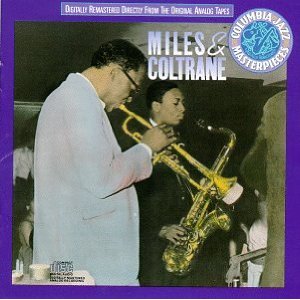
Miles & Coltrane is a live album by American jazz musician Miles Davis, released in 1988 by Columbia Records. The music was recorded at two different shows—one on July 4, 1958, at the Newport Jazz Festival, and one from October 27, 1955, in New York. The tracks have been digitally remastered directly from the original analog tapes.
"Nardis" is a composition by American jazz trumpeter Miles Davis. It was written in 1958, during Davis's modal period, to be played by Cannonball Adderley for the album Portrait of Cannonball. The piece has come to be associated with pianist Bill Evans, who performed and recorded it many times.

